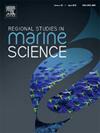Bridging the gap: Seven new distributional records from the west coast of India with phylogenetic reconstruction of the Indian deep-sea Ophidiiformes
IF 2.1
4区 环境科学与生态学
Q3 ECOLOGY
引用次数: 0
Abstract
The Ophidiiformes are known for vast depth range and cryptic appearances, which poses a formidable identification challenge based solely on traditional meristic and morphological characters. A comprehensive integrated taxonomic approach of 19 Ophidiiform species from the west coast of India is presented here and also documented are the first records of Ophidion smithi; Pycnocraspedum squamipinne; Neobythites analis; Neobythites fasciatus; Neobythites stefanovi; Grammonus robustus and Saccogaster maculata in the region. This study confirms the presence of Dicrolene introniger in Indian waters, previously regarded as doubtful. The majority of the species collected in the study belonged to the Ophidiidae family. The genetic analyses suggest a close kinship between the species Neobythites stefanovi and Neobythites steatiticus (3.4 %) while Pycnocraspedum squamipinne and Glyptophidium oceanium emerge as the most distinctly divergent pair (39.4 %). The phylogenetic reconstruction revealed that Ophidiiformes form a monophyletic arrangement. Among the five families observed in the study, Ophidiidae family exhibited a monophyly while Bythitidae and Dinematichthyidae resolved as sister taxa. This study advocates for further comprehensive research on Indian deep-sea fishes to explore deep-sea fisheries and sustainable utilization of these often-overlooked fishery resources.
求助全文
约1分钟内获得全文
求助全文
来源期刊

Regional Studies in Marine Science
Agricultural and Biological Sciences-Ecology, Evolution, Behavior and Systematics
CiteScore
3.90
自引率
4.80%
发文量
336
审稿时长
69 days
期刊介绍:
REGIONAL STUDIES IN MARINE SCIENCE will publish scientifically sound papers on regional aspects of maritime and marine resources in estuaries, coastal zones, continental shelf, the seas and oceans.
 求助内容:
求助内容: 应助结果提醒方式:
应助结果提醒方式:


